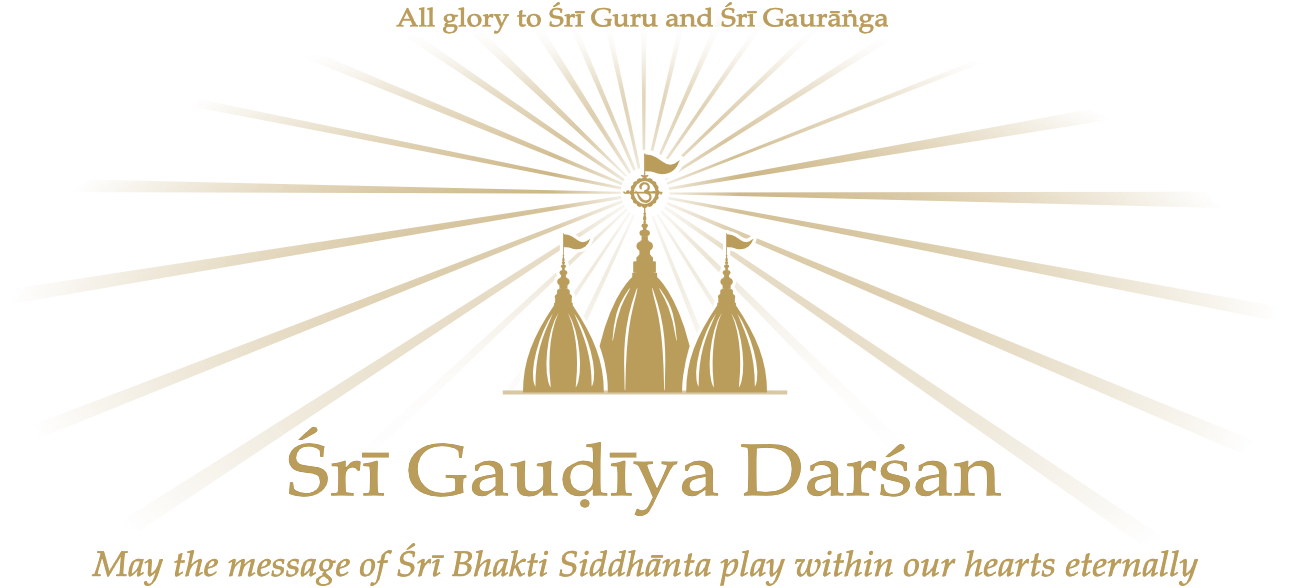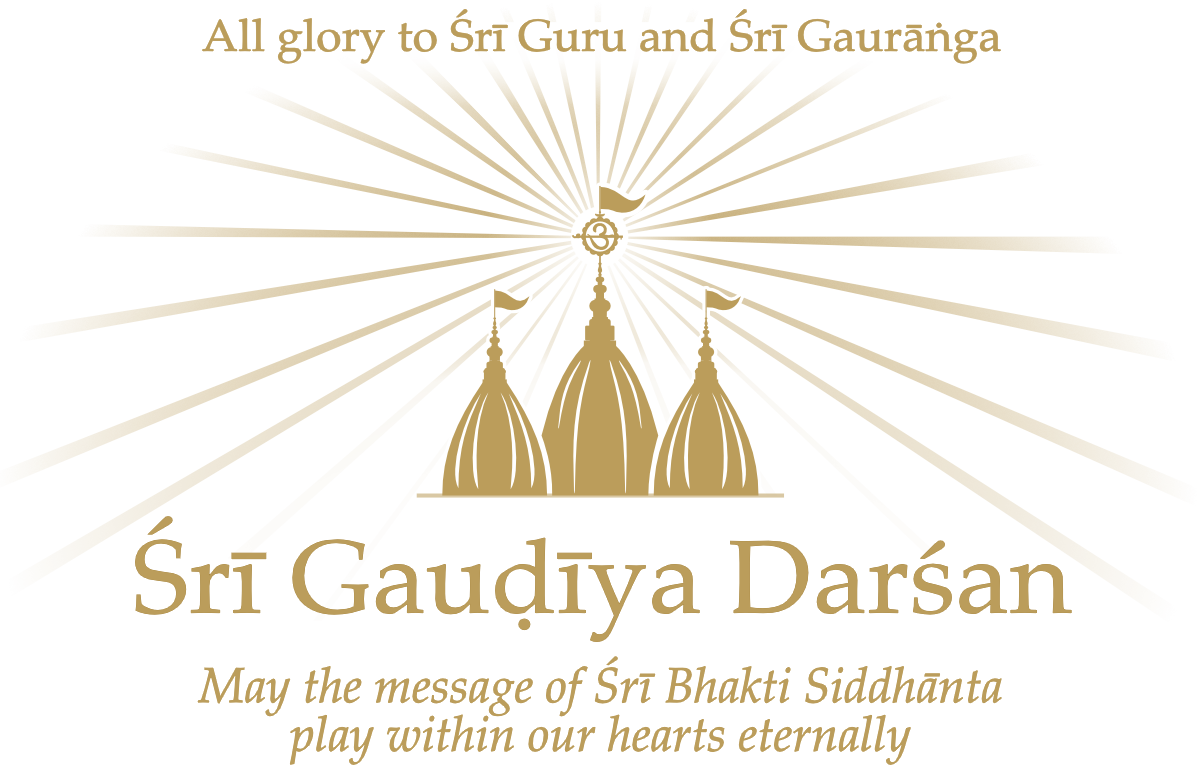Śrīla Bhakti Rakṣak Śrīdhar Dev-Goswāmī Mahārāj explains the scope in meaning of the Hare Kṛṣṇa mahāmantra.
Student: Does the mahāmantra represent Kṛṣṇa?
Śrīla Śrīdhar Mahārāj: Yes, according to realisation. When one will have absolute attraction for Kṛṣṇa-līlā, when one will feel that Kṛṣṇa-līlā is supreme and above law, then the inner meaning of the word Rāma in the mahāmantra will be Rādhā-ramaṇ Rāma.
There is only one centre where all souls and forces are accommodated together. Some say that is Brahma, some say that is Paramātma, some say that is Nārāyaṇ, and Bhāgavatam, the school of Śrī Chaitanyadev, Nimbārka Āchārya, and others say that this centre is Kṛṣṇa. So, the source, the ultimate source, is the spring of everything: all power, all beauty, and all existence. But beauty is really the centre, not power and not an inert stage, an indifferent brace of consciousness. The centre is not the all-pervading aspect, the Paramātma, the aspect which pervades everything, the aspect of the cause which we find everywhere within everything. And the centre is not the all-accommodating aspect, Brahma, the aspect within which everything exists, the aspect which embraces all sorts of consciousness. Neither the all-permeating aspect nor the all-containing aspect are the real position of the absolute cause. The absolute cause must be the object of all movements. In Hegelian philosophy, it is by itself and for itself. ‘For itself’ means He exists for Himself and not for others. So, we exist for Him. Bhagavān means bhajanīya: not only does He hold us and not only does He permeate through us all, but He attracts us to give us fulfilment in His service. Here, the ultimate cause comes to the position of Nārāyaṇ, Puruṣottam [the Supreme Person]. Then, the question comes: is there any understanding between us and Him that we shall give Him a certain amount and we shall get for ourselves a certain amount? Or is He the absolute master? Does everything of ours belongs to Him? Are we in His possession? Can He make or mar us, do anything at all with us? Does He have such a connection with us that at the cost of our existence He may be gratified? When we accept His absolute position in this way, then we will find that He is love and He is beautiful. Then, we will come to understand the prime cause of the whole.
Everything ends in the conception of Kṛṣṇa. So, the remotest connection of the meaning of every word takes us to Him. If we go to make any meaning midway, that will be partial. When Śrīman Mahāprabhu came back from Gayā, He expressed this Himself. He began to explain even through the rules of grammar that everything is Kṛṣṇa and challenged, “If there are any scholars in Nabadwīp, then they should come and try to discard My explanation.” He said that every sūtra and dhātu alludes to Kṛṣṇa. What is a dhātu? Dhātu means potency. Whose potency? The ultimate cause. So, ‘to go‘, ‘to sweep’, ‘to move’, any action is Kṛṣṇa’s śakti: the origin of that action comes from Kṛṣṇa. All words (śabdas) come from Kṛṣṇa, and the meanings of all words cannot but show that their ultimate source is the ultimate centre. So, if the meaning of every word is allowed to move without reins, then it will go to Kṛṣṇa.
Rāma, ramaṇa: in its highest sense, you will find that these words to mean only Kṛṣṇa in Vraja-līlā, and not so much Rāmachandra. Rāmachandra is ramanīya, very beautiful, and when one looks at the figure of Rāmachandra, one is charmed, but Kṛṣṇa is more charming. Rāmachandra and Kṛṣṇa are one and the same, but it is only a posing. Kṛṣṇa is posing as Rāma with charming ways, a charming figure, and charming dealings, but Kṛṣṇa Himself is more charming. He is the centre of the centre. In this way, ordinarily we may take Rāma to mean Rāma of Ayodhyā, Rāma the son of Daśarath, but if we become acquainted with the highest plane of life, the subtle-most plane of life, then we’ll find that the centre of all charm is Kṛṣṇa. There is also differentiation in the form of Kṛṣṇa: the Kṛṣṇa of Vraja is greater than the Kṛṣṇa of Dvārakā. It is represented in the scripture that when Dvārakā Kṛṣṇa saw His own portrait as Vraja Kṛṣṇa, He was charmed: “Oh, how beautiful was I? Now I am not so beautiful.” So, there is differentiation in Kṛṣṇa also, what to speak of in other incarnations of Him.
We may think Rāma means Daśaratha Rāma, or that Hare sometimes means Nṛsiṁhadev, but in the ultimate sense, it will come that here Hare is not Hari but Harā. In the vocative case, as latā becomes late and mālā became māle, so Harā becomes Hare. Harā means She who can capture, who can snatch the highest position. So, we find Rādhikā. Why? She can snatch away the mind of Kṛṣṇa, what to speak of others. Harā means Rādhā in the highest sense of haraṇa, stealing, snatching—attracting. So, Hare Kṛṣṇa means Rādhā Kṛṣṇa. Kṛṣṇa is He who attracts everybody, and Rāma is He who can please everybody, and more specifically Rādhā-ramaṇa Rāma, He who can please even Rādhikā. With the sense that Rāma means He who holds the supreme position of attracting and pleasing everyone, we enter Kṛṣṇa-līlā and find that Rāma is Kṛṣṇa and Harā is Rādhā. Those who enter that plane cannot deviate from it to any other plane. The plane of Rāmachandra is mixed with morality, politics, satisfying subjects, protecting the people, and so on. The absolute transaction of love, in parakīya-rasa especially, is found in Kṛṣṇa-avatār. When one enters that plane, one becomes charmed there and can’t come down to see things from any other plane. It is the central and highest position, and gradually we are to come to know that.
Source
Spoken 2 October 1981.



Leave a Reply